From the co-author of two previous Batsford lace titles comes a collection of 50 stunning lace patterns that showcase the delicate beauty of this ever-popular lace. Traditionally, the ornate braids that make up Milanese lace were used in long, convoluted floral patterns, but they are also easily adapted for use in more modern designs. This new book of patterns contains both traditional and contemporary examples, and the author experiments with a variety of decorative styles. Introducing vibrant colour into Celtic lettering, or delicate braids into exquisite Japanese miniatures are just some of the ideas included. The collection includes a range of patterns to suit all tastes and abilities, from butterflies and dragons to more adventurous designs that will tempt even the most experienced lace-maker, such as Twin Peacocks and Arion Astride the Dolphin. from full-size prickings to working diagrams and braids. from full-size prickings to working diagrams and braids.
Expert advice and clear, step-by-step instructions throughout means that making Milanese lace has never been easier, while lavish photography provides a useful reference and inspires you to create your own stunning pieces. Patricia Read is a well-known and prolific lacemaker and teacher. Coming from a family tradition of lacemaking, she is a member of the Lace Guild, and has taught the craft since 1949 in adult education classes, workshops and residential courses. She is the co-author of Milanese Lace: Art Introduction and New Braids and Designs in Milanese Lace, both published by Batsford. MILANESE LACE PATTERNS  MILANESE LACE PATTERNS PATRICIA READ
MILANESE LACE PATTERNS PATRICIA READ 
First Published as eBook in 2014 by Batsford 1 Gower Street London WC1E 6HD An imprint of Pavilion Books Company Ltd Copyright Patricia Read 2004 The right of Patricia Read to be identified as Author of this work has been asserted by her in accordance with the Copyright, Designs and Patents Act 1988. eISBN 978-1-849942-01-0 All rights reserved.
No part of this work may be reproduced or utilized in any form or by any means, electronic or mechanical, including photocopying, recording, or by any information storage and retrieval system, without the prior permission of the publishers. www.pavilionbooks.com
ACKNOWLEDGEMENTS I wish to thank all my students who have encouraged me to produce this volume of patterns for Milanese lace. Special thanks are owed to my husband, John Read, who has produced the photographic illustrations. I am also grateful to the Dover Pictorial Archive Series. CONTENTS  INTRODUCTION I am pleased to present this book of original Milanese lace patterns with contributions from some of my students and my family. Some of the patterns, such as Spray and Acanthus, are traditional in form, while others have been developed from different artistic styles, such as those of Celtic and Japanese art.
INTRODUCTION I am pleased to present this book of original Milanese lace patterns with contributions from some of my students and my family. Some of the patterns, such as Spray and Acanthus, are traditional in form, while others have been developed from different artistic styles, such as those of Celtic and Japanese art.
The braids themselves were first published in The Technique of Milanese Lace and New Braids and Designs in Milanese Lace, both by myself and Lucy Kincaid, which many lacemakers have found interesting, fascinating and a challenge. Sometimes, the intricate pattern of a decorated braid can initiate a design. For the most part, however, it is a question of deciding which braid is most suitable for use within a particular pattern. In this way, the braids have become a source of inspiration for those who like to design their own lace. This is a collection for those lacemakers who prefer to choose a prepared pattern with the support of work notes. There is a range of patterns for all abilities, from Catherines Heartsease (Catherine is aged 8) to Jacquies Basil, and a variety of patterns, ranging from jabots, mats and motifs to pictorial items intended for framing, including many in colour.
For those lacemakers who like to experiment, here is an opportunity to try certain techniques that may be new: for example, the division of the braid in Circular Crane, and the crossing of the braids in Split Braids. Above all, I hope these pieces will give pleasure to all lacemakers. Patricia Read  Arion Astride the Dolphin EXPLANATORY NOTES With one exception, the patterns given in this book are shown at the correct size. The exception is the Dragon in Colour (page 58). For this, the pattern of the Dragon in White needs to be increased on a photocopier by between 18 and 20 per cent. It is recommended that patterns should be pricked on pricking card.
Arion Astride the Dolphin EXPLANATORY NOTES With one exception, the patterns given in this book are shown at the correct size. The exception is the Dragon in Colour (page 58). For this, the pattern of the Dragon in White needs to be increased on a photocopier by between 18 and 20 per cent. It is recommended that patterns should be pricked on pricking card.
It is more difficult to take clean sewings when using cardboard (especially carton packets) and matt adhesive. For some lacemakers, the technique of rolling the edges (footside) may be new. For working this see page 117. Rolling gives a pleasing, firm appearance to the edge of the lace and raises the edges of braids within the work, creating a sculptured effect. The braids needed for each pattern are listed in order of use. Diagrams are provided at the back of the book where each braid is shown as a working diagram with the number of pairs given.
Most of the braids can, in fact, be worked with a varying number of bobbins to suit the width of the braid being made. Pairs can be added to or omitted from the straight footside pairs or from the meandering trails. To work in colour, plan the route of the coloured thread by placing tracing paper over the working diagram of the proposed braid and then tracing off the route with coloured pencils. The result may be interesting, but perhaps not what is wanted, in which case try a different braid. (Remember that in Turning Stitch one thread of a pair will change, or work a different Turning Stitch.) EQUIPMENTPillow Milanese is a free or part lace, meaning that it is non-continuous. Cover cloths It is important to use these to keep the work clean. Cover cloths It is important to use these to keep the work clean.
One with a 5cm (2in) hole in the centre is ideal for this type of lace, where the pillow is frequently turned, and you will also require a plain cloth to keep the pillow completely covered between each working session. Bobbins Fine English bobbins may be used. Many sewings are taken in decorated braid patterns, therefore neatly wired, small spangles are necessary to avoid catching and possibly breaking the thread. Other types of bobbin may be used, but spangled bobbins have the advantage of extra weight, which prevents the thread from coming untwisted. Thread A variety of threads have been used in the making of the pieces in this book. Cotton threads, such as Madeira Tanne 80, have been most commonly used, but some designs have been worked in silk.
The threads used have been listed with each pattern. Pins In this type of work, pins are pressed down as the work continues, therefore they should not be too long. Size 26mm x .55 is recommended for most threads, but 26mm x .67 can be used for thicker threads, such as Gutterman silk. Tools Most lacemakers have their own favourite tools, but the list of essential items should include a pair of sharp-pointed scissors. Blunt scissors are also required, for cutting card and bowing off. A pricker is used for pricking patterns and a needlepin for taking sewings (these two items are not the same).
A fine hook may also be used for sewings. (If using a wig hook, make sure it is not sharp.) For health and safety reasons, keep needle points in corks and sharp objects in containers. Stitch holders are useful for bobbins that are being set aside while other work is in progress. 
Next page
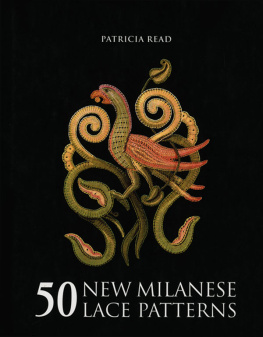

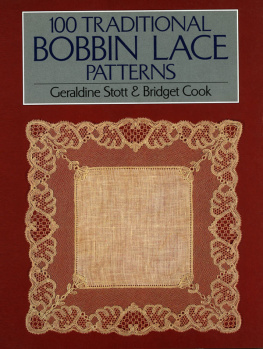

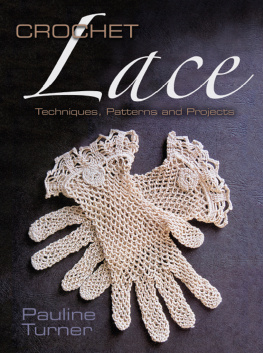
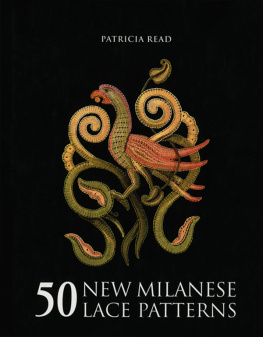
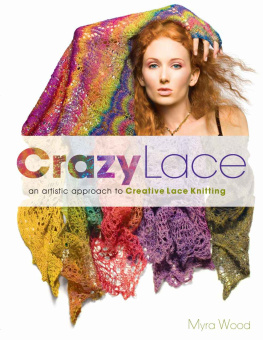
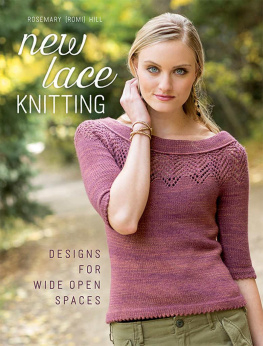
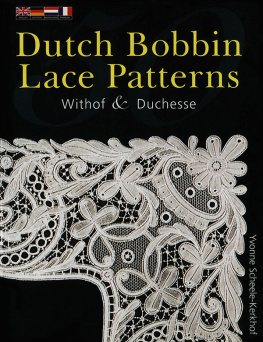

 MILANESE LACE PATTERNS PATRICIA READ
MILANESE LACE PATTERNS PATRICIA READ 
 INTRODUCTION I am pleased to present this book of original Milanese lace patterns with contributions from some of my students and my family. Some of the patterns, such as Spray and Acanthus, are traditional in form, while others have been developed from different artistic styles, such as those of Celtic and Japanese art.
INTRODUCTION I am pleased to present this book of original Milanese lace patterns with contributions from some of my students and my family. Some of the patterns, such as Spray and Acanthus, are traditional in form, while others have been developed from different artistic styles, such as those of Celtic and Japanese art. Arion Astride the Dolphin EXPLANATORY NOTES With one exception, the patterns given in this book are shown at the correct size. The exception is the Dragon in Colour (page 58). For this, the pattern of the Dragon in White needs to be increased on a photocopier by between 18 and 20 per cent. It is recommended that patterns should be pricked on pricking card.
Arion Astride the Dolphin EXPLANATORY NOTES With one exception, the patterns given in this book are shown at the correct size. The exception is the Dragon in Colour (page 58). For this, the pattern of the Dragon in White needs to be increased on a photocopier by between 18 and 20 per cent. It is recommended that patterns should be pricked on pricking card.